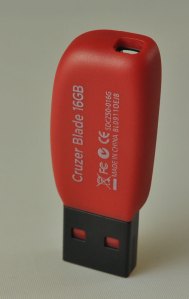Flash Review – Sandisk Cruzer Blade – One Year On, An Update
I’ve been using the flash drive almost every day, and today, I’m writing an update to the original Sandisk Cruzer Blade review – I’m going to run some of the same test software and it’s the same flash drive but I want to see what a year of read and write cycles has done to performance..
The original review used CheckFlash, Barts Stuff Test and Crystal Disk Mark to compare the performance of the Cruzer Blade against the Cruzer Micro I was replacing. There were some complaints originally about comparisons with different sized drives and of different models, so this review looks only at the read / write speeds of the Cruzer Blade and how a year of usage has affected performance.
The software I’m using to test the devices has changed in version only, the physical way in which the drives are tested is relatively unchanged – a file is written to the drive and verified, and the read and write speeds are calculated.
You can download the test software yourself, from the following locations.
CheckFlash by Misha Cherkes version 1.16
Barts Stuff Test version 5.1.4
Crystal Disk Mark version 3.0.1 – available in 32 bit and 64 bit versions.
The test system is a custom-built i7 930 with 6GB ram, running windows 7 x64.
The Cruzer Blade is formatted to fat32.
Check Flash
Check flash was run using the ‘temporary file’ option, on a fat32 file system, this limits the maximum file size written to 4gb, which should be enough for an accurate test result.
Crystal Disk Mark
Barts Stuff Test
BST creates a temporary file on the drive and performs a sequential write test with verify to determine average read and write speed.
H2TestW
And new for this review is h2Testw – a program written by a German computing magazine for determining if your flash drive really has the capacity the drive controller is reporting to the operating system.
For example, if you have what appears in Windows to be a 32gb flash drive, but physically it’s only a 4gb memory chip, this program will detect errors in copying data beyond the capacity of the drive, alerting you to the fake capacity and preventing data loss..
As part of this process, it also determines read and write speed of the device.
So the Cruzer Blade achieved a final value of 16.1MB/sec read 4.98MB/sec write in this test.
Conclusions
The software tools used to determine flash drive read and write speeds vary in terms of ease of use, and software build quality.
I would rate the Barts Stuff Test program the lowest quality in terms of programming and user interface. During testing, it crashed at the 4gb hardlimit for the fat32 filesystem – it failed to take this into account when starting the test.
Crystal Disk Mark is the most comprehensive test program, testing random and sequential write modes in different block sizes and queue depth. For a simple average read / write speed test it’s overkill.
I find CheckFlash is the most useful program for me, as it shows a pictorial representation of the process, indicating wether faults have been found during the test, althought a downside is the user interface for selecting options – it’s a little untidy.
So, from the results gathered from our 4 test programs, we can average our results into an overall read / write speed for the Cruzer Blade in fat32.
Read MB/sec - Write MB/sec Check Flash - 16.47 - 4.96 Barts ST - 16.40 - 4.70 Crystal DM - 17.27 - 5.38 h2testw - 16.10 - 4.98 Average - 16.56 - 5.00
So we can see, for the 16GB cruzer blade, average Read speed is 16.56MB/sec and average Write speed is 5MB/sec.
In real terms, this means the average time taken to write a 1GB file, (1000MB,) to the Cruzer Blade would take approximately 200 seconds, or 3 minutes 20.
If we compare this set of results to the previous round of testing, we can see the old test results were a lot less grouped, with very low read speed reported by CheckFlash and possible incorrect average write speed from BST. Here is the original output from CDM.
The average sequential read speed of 17.23MB/sec and write speed of 5.047MB/sec very closely match the latest results and indicate no significant loss of performance over the year.
The drive is still very slow, with prices for the 16GB around £14 with delivery it’s cheap enough, but my advice? Spend your money on something with better performance.
For good price/performance, try the SuperTalent USB 3.0 8GB or 16GB drives for super 67MB/sec read and 23MB/sec write speeds. For those with USB 2 only, yet looking for a high speed drive, try the 32GB Corsair Flash Voyager GTR with 34MB/sec read and 28MB/sec write performance. Costly, at about £60, do NOT be tempted by the cheaper GT version.
These read / write speeds are manufacturers claims and I have not tested or verified them as such.






The copy speed is not more than 2.4 MB/S. It is not a great flash drive.
Hey there…
This is a very good article and exactly what I’m looking for.
Not like you, I buy computer stuff by considering the design not the performance. lol
That’s why I was going to buy Sanddisk Cruzer Blade. but after I read this article i change my mind..
Two thumbs up. 😀